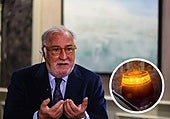All the Worlds of Proust Converge at the Thyssen
The Museum recreates the aesthetic and emotional universe of the writer through works by great masters of painting
Miguel Lorenci
Madrid
Monday, 3 March 2025, 15:46
Art transcends and conquers the time that destroys everything. Marcel Proust (1871-1922) aimed to demonstrate this with one of the most monumental narrative adventures in history. The seven titles with which he sought to recover lost time. The brilliant French writer believed that each work of art illuminates a world, just as his novels did. Many of these worlds are now concentrated in the Thyssen-Bornemisza Museum, which in the exhibition 'Proust and the Arts' hosts 136 works by giants of art. On display until June 8, it represents the art recovered by Proust and highlights the importance this had for one of the most influential writers of the 20th century.
Proust believed that "the world is recreated as often as an original artist emerges" and that "only through art can we leave ourselves and see other worlds." Universes encapsulated in works by El Greco, Tintoretto, Rembrandt, Vermeer, Van Dyck, Turner, Fantin-Latour, Whistler, Ruskin, Manet, Monet, Degas, Renoir, Watteau, Zuloaga, or Leger, among many others. All painters admired by Proust, whose works are spread across the nine rooms of a brilliant exhibition with which Fernando Checa, its curator, recreates these Proustian worlds.

There are also sculptures, engravings, drawings, costumes - some by Fortuny, who was almost a character in Proust's works - fabrics that belonged to the writer, photos, and books. The first editions of the seven volumes 'In Search of Lost Time', published between 1913 and 1927 and loaned by the National Library of France, and his first work, 'Pleasures and Days' (1896). This is presented in the first room to testify to the early taste for the arts, music, theatre, and especially painting with his frequent visits to the Musée du Louvre.
The journey through the narrator's emotions and aesthetic tastes opens with a photo of a very young Proust portrayed by Nadar at only fifteen years old, and closes with the image of the writer on his deathbed, alongside two self-portraits of Rembrandt in maturity and old age that testify to that defeat of time that art combats.

It is an exquisite journey through several centuries of the finest art through pieces that demonstrate Proust's interest in architecture, fashion, technique, or cars, like the one he used to tour the Gothic cathedrals of France. "He was as interested in the past as in modernity," says Dolores Delgado, curator of ancient painting at the Thyssen and technical curator of the exhibition.
Secret Passion
Proust is "a secret passion" of Fernando Checa, former director of the Prado and a great specialist in ancient painting, who has dedicated more than three years to preparing the exhibition. "It is the exhibition of a 'Proustophile', but it is not a fetishistic exhibition, full of objects. It breaks with conventional criteria of staging to not be chronological, as Proust is the author of the most anti-chronological novel," highlights Guillermo Solana, artistic director of the Thyssen.
The exhibition traverses and reflects the artistic, monumental, and landscape environments that surrounded him and that Proust recreates in his books always through the artists who served as his stimulus. It allows understanding of the Paris in which he lived: The cosmopolitan, effervescent, and rich capital of the Third Republic, its great transformation after the urban reforms of Baron Haussmann, with the advent of electricity, cars, shows, restaurants, and cafes, and the catastrophe of World War I.

It delves into the little-known "Spanish connection" of Proust through the figures of Mariano Fortuny, Ignacio Zuloaga, or Raimundo de Madrazo. It exhibits some dresses and fabrics designed by the former to highlight the crucial interest of the French author in fashion. From Zuloaga, it shows a formidable portrait of the Countess Mathieu de Noailles, and from Madrazo, two other portraits, of the painter's wife María Hahn and of Laure Hayman. The importance of theatre in Proust's work is appreciated in the impressive painting by Georges Clairin, depicting the actress Sarah Bernhardt, a figure on whom Proust based, among others, the character of La Berma, present throughout the novel, from the Petit Palais museum in Paris.

Proust was also passionate about the image of modernity created by the Impressionist painters in their depictions of the streets and other Parisian settings: the Champs-Élysées, the Bois de Boulogne, and the palaces of the aristocracy of the Faubourg Saint-Germain, or the beaches and coasts of northern France. These are some of the settings in which the novel unfolds and which were reflected by painters like Édouard Manet, Camille Pissarro, Pierre-Auguste Renoir, Claude Monet, Eugène Boudin, or Raoul Dufy. The Thyssen has made one of the icons of the exhibition the painting 'Rue Saint-Honoré in the Afternoon. Rain Effect', painted in 1987 and the subject of a long-standing legal dispute, which still lingers between the museum and the heirs of the family from whom it was looted by the Nazis.
The exceptional exhibition would not have been possible without the generosity of lenders such as the Louvre, Orsay, and Carnavalet museums in Paris, the Mauritshuis in The Hague, the Rijksmuseum in Amsterdam, the Städel in Frankfurt, and the National Gallery of Art in Washington, the Prado, and the Museum of Fine Arts of Bilbao.




